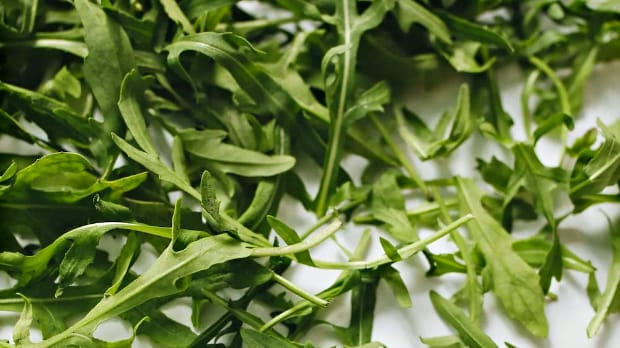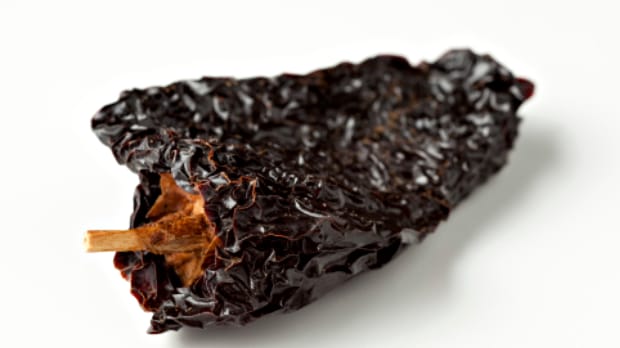What is a Habanero Pepper?
The habanero pepper, pronounced ha-ba-NEH-ro, is a type of chili pepper that is grown mostly in the Yucatan region. This pepper is in the shape of a lantern and packs a powerful punch, reportedly having a heat level 60 times hotter than that of a Jalapeño. Due to its spiciness, it should be handled with plastic gloves. If you don’t have any gloves available, try using a plastic sandwich bag instead. Habaneros come in a variety of colors such as green, dark green, red, or orange-red. When the pepper is ripe, it has a fruitier and sweeter taste than its unripe counterpart. This fiery pepper is considered to be one of the hottest peppers in the world and is commonly used in Mexican and Caribbean cuisine.
- What is a Habanero Pepper?
- What are the Nutritional Benefits?
- Types Available
- What are the Best Uses for Habanero Peppers?
- How do You Store Habanero Peppers?
- How to Prepare a Habanero Pepper
- When are Habanero Peppers in Season?
- What to Serve Habanero Pepper With?
- What Traditional Cuisines Use Habanero Pepper?
- Tasty Recipes
- Key Takeaways
What are the Nutritional Benefits?
Spicy chilis can be great way to add a lot of flavor to food. They can also be the inspiration for challenges, and produce a lot of laughs, but do they actually have health benefits? You may know the habanero pepper as a spicy spice, but it is also packed with nutritional benefits! For starters, the habanero pepper is an excellent source of Vitamin C, which can help boost your immune system. It is also full of dietary fiber, which can aid in digestion and help prevent chronic diseases such as heart disease and diabetes.
But the benefits don’t stop there. Habanero peppers also contain capsaicin, a compound that has been shown to help increase metabolism and reduce inflammation. And if you’re looking to add a little bit of heat to your dishes, habanero peppers are a great way to do it. They are a delicious, nutritious, and versatile ingredient that can add flavor and health benefits to your meals. So go ahead and spice up your life with some habanero peppers!

Types Available
If you’re a fan of spicy food, you’ve likely heard of the habanero pepper. It’s often as easy to find in the grocery store as jalapeños. This small but mighty pepper packs a serious punch in terms of heat and flavor. But did you know that there are several different types of habaneros available?
First, there’s the classic orange habanero, which is the most commonly found variety. It’s known for its fruity, citrusy flavor and high level of heat. Next up is the red habanero, which is considerably spicier than its orange counterpart but has a deeper, richer flavor.

If you’re looking for something even spicier, you might try the chocolate habanero. This variety, sometimes called the black habanero, is incredibly hot and has a unique smoky flavor that pairs well with savory dishes. Finally, there’s the yellow habanero, which is the mildest of the bunch. It has a fruity, almost sweet flavor and is great for adding a subtle kick to dishes without overwhelming them with heat.
No matter which variety of habanero you choose, be sure to handle them with care – these peppers are seriously hot! But if you can handle the heat, they’re a delicious and exciting addition to any dish.
What are the Best Uses for Habanero Peppers?
Are you looking to spice things up in the kitchen? Look no further than the habanero pepper! This fiery little fruit is native to South America and packs a serious punch. But don’t let its intimidating reputation scare you away. With the right technique, the habanero can add a delicious kick to any dish. Here are some of the best ways to use habanero peppers.
Hot sauce: One of the most popular uses for habanero peppers is in hot sauce. Blend them with vinegar, garlic, and salt to create a spicy condiment that pairs well with anything from eggs to tacos.
Salsa: Habaneros also make a great addition to salsa. Mix them with tomatoes, onion, and cilantro for a fresh and spicy dip that’s sure to impress.
Marinades: Habanero peppers are an excellent ingredient for marinades. They add a bold flavor to meats like chicken, steak, and pork. Just be sure to use gloves when handling them, as their oils can irritate the skin.
Cocktails: If you’re feeling adventurous, try adding habanero peppers to your cocktails. Muddle them with lime and sugar for a spicy twist on a classic margarita.
Stews and Soups: Toss a habanero chili pepper in your stews and soups for a hot and spicy warmth during winter months. Just remember, when working with habanero peppers, use caution. Always wear gloves, and be sure to keep your hands away from your eyes and face. With a little care, the habanero pepper can add a bold and exciting flavor to your favorite dishes.
How do You Store Habanero Peppers?
If you’ve ever bought habanero peppers, you know they can add the perfect kick to your favorite dish. But what do you do if you have too many habaneros and need to store them for later use? The best way to do this is to keep them in a cool and dry place. One great option is to place them in a paper bag and store them in the vegetable compartment of your refrigerator. This will help to keep them fresh for up to a week. If you need to store them for longer, you can also freeze them. Simply wash and dry the peppers, cut off the stem, and place them in a freezer-friendly bag. You can then use them as needed, straight from the freezer.
It’s important to note that habaneros are a hot pepper and can cause irritation if they come into contact with your skin or eyes. Be sure to wear gloves when handling them, and be careful not to touch your face or eyes while you’re working with them.
By properly storing your habaneros, you can enjoy their spicy goodness for weeks to come!
How to Prepare a Habanero Pepper
Let’s talk about how to prepare the notorious habanero pepper. If you’ve never cooked with habaneros before, you might be intimidated by their heat level. But fear not! With a little bit of prep work, you can tame this fiery pepper and add a delicious kick to your next dish. First things first, it’s important to protect your hands and eyes from the pepper’s intense heat. Wear gloves and avoid touching your face while handling habaneros. Once you’re geared up, give the pepper a thorough rinse under cool running water.
Now, let’s talk about prepping the pepper. The heat of a habanero is concentrated in its seeds and inner membranes. So, to tame the heat, you’ll want to remove these parts of the pepper before cooking. Start by slicing off the habanero’s stem and then slice the pepper in half lengthwise. Use a spoon to scoop out the seeds and inner membranes, discarding them as you go.
Now that you’ve removed the spiciest parts of the pepper, you can chop it up and add it to your dish. The pepper pairs well with tropical flavors like pineapple or mango, and it’s a great addition to salsas, marinades, and hot sauces. Remember, even though you’ve removed the seeds and membranes, habaneros still pack some serious heat. Use them in moderation until you’ve built up a tolerance. Happy cooking!
When are Habanero Peppers in Season?
Are you a fan of spice? If so, you probably know about habanero peppers. These little fiery fruits can add bold flavor to any dish. But have you ever wondered when the best time is to find them fresh at your local grocery store or farmers market? The answer may surprise you. Habanero peppers are known for being particularly sensitive to changes in temperature and sunlight. This means that they thrive in hot, sunny weather – which is why they tend to grow best during the summer months. So if you’re looking to get your hands on some fresh, juicy habaneros, summer is the season to keep in mind.
Of course, this can vary depending on where you live. Some regions may experience hot summers and mild winters, which means that habaneros could potentially be available year-round. On the other hand, colder climates may only see habaneros in stores during the summertime.
But no matter where you are, there are always ways to enjoy habanero peppers. You can find them in a variety of forms, such as dried powder or hot sauce, that can be used all year long. You might be able to find pickled habaneros at your grocery store or online. So if you’re a spicy food lover, make sure to give this fiery little pepper a try – whether it’s in season or not.
Improve Your Health With Seasonal Eating
What to Serve Habanero Pepper With?
- Rice
- Avocado
- Corn
- Black beans
- Tomatoes
- Onions
- Cilantro
- Lime juice
- Cheese
- Sour cream
What Traditional Cuisines Use Habanero Pepper?
Habanero peppers are most commonly used in Mexican, Caribbean, and Central American cuisines. They are often used to add heat to dishes such as salsa, chili, stews, and sauces. They are also used in marinades and dressings for meats, vegetables, and fruits.
Tasty Recipes
- Habanero Hot Sauce
- Grilled Shrimp With Orange-Habanero Mojo
- Mango-Habanero BBQ Chicken Recipe
- Creamy Habanero Guacamole
- Mango Habanero Black Bean Tacos
Key Takeaways
- Wear gloves when handling habanero peppers to avoid contact with the oils that cause burning sensation and irritation.
- Habanero peppers are extremely hot and should be used sparingly in dishes.
- The heat from habanero peppers can be moderated by cooking them or combining them with other ingredients like tomatoes, onions, and garlic.
- Habanero peppers can be eaten raw, but use caution when consuming them as they are very spicy.
- To reduce the heat of habanero peppers, remove the seeds and membranes before using them in recipes.
- Habanero peppers can be frozen for up to six months without losing flavor or texture.
References: Antioxidant activity of Habanero pepper (Capsicum chinense Jacq.) fruits | Phytochemical Profile and Antioxidant Activity of Habanero Peppers (Capsicum chinense Jacq.) | Habanero pepper (Capsicum chinense) as a source of bioactive compounds | Health-promoting compounds of habanero pepper (Capsicum chinense Jacq.) | The health benefits of hot peppers




